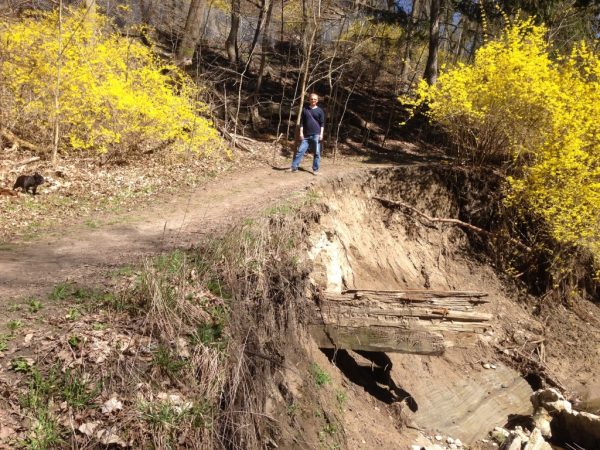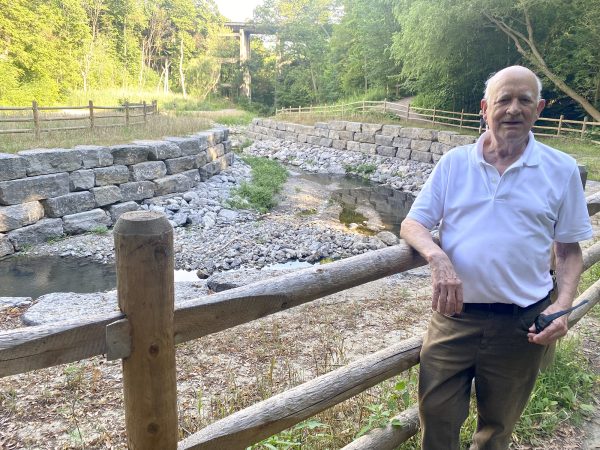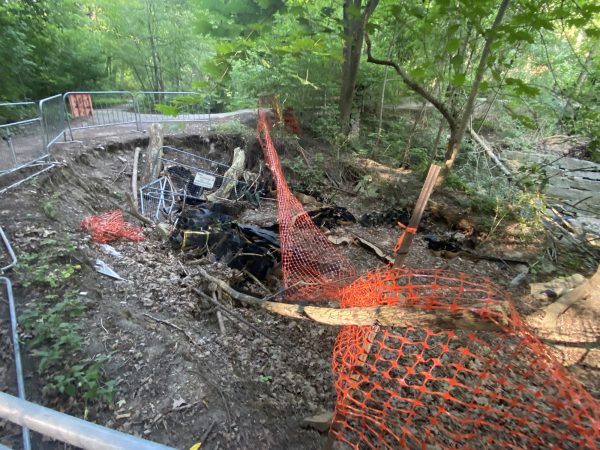Because the summer of 2025 has been all about infernal heat and drifting smoke, as opposed to the Biblical downpours of recent years, the public/media conversation about climate hasn’t focused on the calamitous damage wrought by major flood events.
Such as: the July, 2013, inundation of the lower Don and the GO corridors in a matter of hours. Or a similarly scaled downpour last July. Or the millions in damage caused by flooded basements in the north end of the city. Or the half billion dollars the city had to spend in 2005 to rebuild washed out sections of Finch Ave., as well as shredded sewer mains in some ravines.
Lots of examples, but none, so far, this year.
The folks who pay especially close attention to the collateral damage caused by these massive and increasingly frequent storms take the long view, of course, and have been pushing the city and the region for years to confront our vulnerabilities. Their advocacy, in many notable cases, has borne fruit, in the form of giant storm-water overflow tanks along the lakeshore, the Corktown Common berm and, as of this year, the reconstruction of the mouth of the Don, which is every type of lovely but fundamentally about flood protection.
For all that, when Toronto’s beloved but often neglected ravines take it in the teeth, the city’s response is uneven.
In some instances, the city and the Toronto Region Conservation Authority (TRCA) have moved with determination, as happened in the latter 2000s when successive summer storms ripped up infrastructure under Wilket Creek Park, south of Edwards Gardens, necessitating first emergency remediation and then the implementation of a long-term master plan meant to shore up vulnerable banks, reaches and slopes. That work has been ongoing for the past 15 years.
Elsewhere, the city and TRCA carried out major restoration work along Mud Creek, which runs between Moore Ave. and the Brickworks, to address flooding risk that has threatened the popular naturalized former mine. As recently as last year, in fact, the city embarked on emergency repairs in one spot near the Brickworks wetlands after a heavy July, 2024, downpour washed away an embankment.
(Mud Creek has also been on the receiving end of far-sighted accessibility improvements, both at the north end, and despite the histrionics of some Rosedale residents’ groups, further south, in the form of a switch-back path linking the trail system to Chorley Park.)
The counter-example lies just to the west in the form of Yellow Creek, a Don River tributary that snakes through a series of North York storm sewers and surfaces just south of the Mount Pleasant Cemetery, where it runs through the Vale of Avoca and then part of the ravine separating north and south Rosedale.
On a sultry afternoon early in the summer, John Bossons, a retired economist and spokesperson for the Midtown Ravines Group, which represents ten nearby residents’ associations, gave me a tour of this park, which begins at the cemetery’s gate, passes under the Vale of Avoca viaduct and then meanders down to Mount Pleasant Road.
He and the other members recently scored a big win — a $1.5 million commitment from council, passed in July, to develop a master plan to confront the erosion that is ravaging the ravine, its slopes, the creek bed and the trails that crisscross the park. (The local MPP Kristyn Wong-Tam had encouraged the coalition to get organized; earlier this spring, a delegation got in to see Mayor Olivia Chow.) However, a master plan, with all the hydro-geological trimmings, is necessary but not sufficient. The estimated remediation cost is $35 million — at least.
Yellow Creek ravine is an over-grown and highly atmospheric jumble: rotting stairs up to the street, the viaduct’s cathedral-like underside, chunks of concrete around the river, old ghost roads, rusty storm water outflows, and the steam-punk-y footings of the CPR trestle bridge.
In the late 19th century, Bossons explained, “this was a destination park. The streetcar, when it was horse-drawn, ended below the hill going up to St. Clair. So people would come up here. There was actually an amusement park up on an estate that got sub-divided in 1911 and the city made [the ravine] into a city park down below.”
He peeled the historical onion a bit more, pointing to the remnants of a lumber mill from the 1830s, as well as a heavy retaining wall along the creek’s east bank, still intact, that dates back to this period. “It’s a beautiful area,” mused Bossons, who has lived nearby for over 30 years and tramped countless times along the trails with his wife, the late midtown city councillor Ila Bossons. “It’s amazing to have a resource like this in the middle of the city.”
The ravine’s more recent landmarks feature erosion: banks that have disappeared, disintegrating rip-rap, and something very sink-hole like near one of the bridges, the result of high waters surging over the shoreline a few metres upstream. We also walked down to a newly constructed flood-protection zone — a couple of hundred metres of creek where the banks have been set well back and then built up to a height that will contain a heavy surge — of the scale that washed away a fairly recent attempt to fortify the creek but evidently didn’t last.
This project, which cost $2 million and was funded by TRCA, feels, well, attenuated. It’s well-designed and sturdily built but is just a Band-aid on a landscape that is being washed away by the truckload. Bossons took me to the ragged edge of a muddy embankment overlooking that old mill, which is vanishing in real time. Later, he emailed me a picture (below) showing how the same embankment looked in 2017. Most of it, including the beaten path, no longer exists.
One reason so little has happened here, compared to other flood-ravaged ravines, is that there’s no municipal infrastructure under the creek, nor does flooding threaten anything downstream, as was the case with Mud Creek and the Brickworks.
After years of trying and failing to get the city’s attention, Bossons says the Midtown Ravine Group’s new game-plan is to get the now-funded master plan completed, with plenty of local input. The group then wants to embark on a fundraising campaign to raise enough private capital to seed a charitable endowment, the proceeds of which would help pay for maintenance and programming, as now exists for the Bentway and the Evergreen Brickworks.
Yet in the long-term, their fiscal strategy turns on what increasingly looks like a leap of faith: using the projected revenues from development charges and parkland acquisition fees, raised from the intensification promised around St. Clair and Yonge, to pay for all the remediation recommended by the eventual master plan.
With a lifeless condo sector, Midtown’s financial strategy looks like a long-shot. Bossons expects the market to rebound in five or six years — optimistic, in my view — and explained that the members opted for a pragmatic approach, one which drew the city’s attention to the fact that at some point, wealthy (mid-town) people will invest in the endowment.
“We came to the conclusion that because of all the financial pressures on the city, whether it’s affordable housing, dealing with the homeless, transit, or whatever, there’s just no prospect right now of serious amounts of money going into this [project]. We need about $30 to $40 million to do the ravine. We figured, `better to try to make this a private-public partnership so we can actually get it done.'”


It’s worth noting that Toronto Water’s ten-year capital plan exceeds $17 billion, the bulk of it funded by water rates. Not long after amalgamation, in the late 1990s, a very different council passed something called the Wet Weather Flow Master Plan, a long-term strategy for spending on a wide range of capital projects involving the city’s water infrastructure.
Many of these involved civil engineering — repairing sewer mains, eliminating combined sewer outflows, confronting basement flooding, treatment plant rehabs, etc. Yet the Master Plan also envisioned more up-stream investments to make the city more absorbent — greening projects, ravine slope rehabilitation, naturalized stormwater management and so on. However, as is probably not surprising, the large-scale engineering-oriented projects have more pull, and now account for 84% of the spending.
Over ten years, Toronto Water will transfer $106 million to the TRCA for erosion control — not a small sum, to be sure, but a line item nonetheless, and one that is dwarfed by state-of-good-repair spending on outlays like sewer mains and treatment plant refurbishments.
Interestingly, the largest capital budget entry is $2.1 billion for “basement flooding relief,” which is classified, like the outlay for erosion control, as a “growth and improved service” investment. In the city’s budget parlance, a `nice-to-have,’ but one that’s, well, twenty times nicer (and even more politically expedient) than fortifying Toronto’s ravines against the accelerating ravages of climate change.
What’s more, the erosion control projects that bob to the surface of Toronto Water’s priority list tend to be those ravines and creeks which also serve as conduits for heavy infrastructure, like buried trunk sewers.
Whether confronting the eroding mess in the Yellow Creek ravine is a nice-to-have, a state-of-good-repair-type project, or little more than a fond wish is a question that certainly merits debate, and I don’t want to pre-judge. At least council is paying attention.
But it’s by no means clear to me that betting on the revival of a speculation-fueled property market is the best way to proceed, not least because the prospect of leveraging DCs to underwrite repairs to climate-induced damage in a vulnerable public space feels like letting the city off the fiscal hook. The entire approach, moreover, pre-supposes that council and the local ward representatives — currently Josh Matlow and Dianne Saxe — don’t lose their interest and decide to direct those levies to some other initiative.
In any event, we’ll see at some point. By which time we’ll have come through more monsoon-like storms that continue to wash away one of the ravines Toronto professes to love.
photos by John Lorinc




